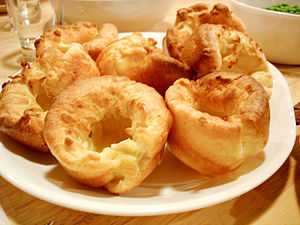Yorkshire pudding
| Yorkshire pudding | |
|---|---|
| Pudding | |
 Mini Yorkshire puddings | |
| Place of origin: | |
| England | |
| Main ingredient(s): | |
| Milk or water, flour and eggs | |
| Recipes at Wikibooks: | |
|
| |
| Media at Wikimedia Commons: | |
|
|
Yorkshire Pudding, also known as batter pudding, is an English dish made from batter consisting of eggs, flour, and milk. The dish is usually served with roast meat and gravy and is a staple of the traditional British Sunday roast. It may also be served as a dessert.[1]
The exact origin of the Yorkshire pudding is, as yet, unknown. The first ever recorded recipe appears in a book in 1737.
History

When wheat flour began to come into common use for making cakes and puddings, cooks in the north of England devised a means of making use of the fat that dropped into the dripping pan to cook a batter pudding while the meat roasted in the oven. In 1737, a recipe for 'a dripping pudding' was published in The Whole Duty of a Woman:[2]
Make a good batter as for pancakes; put in a hot toss-pan over the fire with a bit of butter to fry the bottom a little then put the pan and butter under a shoulder of mutton, instead of a dripping pan, keeping frequently shaking it by the handle and it will be light and savoury, and fit to take up when your mutton is enough; then turn it in a dish and serve it hot.
Similar instructions were published in 1747 in The Art of Cookery made Plain and Easy by Hannah Glasse under the title of 'Yorkshire pudding'. It was she who re-invented and renamed the original version, called Dripping Pudding, which had been cooked in England for centuries, although these puddings were much flatter than the puffy versions known today.[3]
The Yorkshire pudding is meant to rise in a correctly executed preparation. A 2008 ruling by the Royal Society of Chemistry has it that "A Yorkshire pudding isn't a Yorkshire pudding if it is less than four inches tall".[4]
The Yorkshire pudding is a staple of the British Sunday lunch and in some cases is eaten as a separate course prior to the main meat dish. This was the traditional method of eating the pudding and is still common in parts of Yorkshire today. Because the rich gravy from the roast meat drippings was used up with the first course, the main meat and vegetable course was often served with a parsley or white sauce.
Traditionally, though less so now, the Yorkshire Pudding could be served as a sweet, with sugar, golden syrup, jam, or even with orange juice as a sauce.[citation needed]
It is often claimed that the purpose of the dish was to provide a cheap way to fill the diners, thus stretching a lesser amount of the more expensive ingredients as the Yorkshire pudding was traditionally served first.[5]
Cooking method
Yorkshire pudding is cooked by pouring a batter made from milk (or water), flour and eggs into preheated, oiled, baking pans, ramekins or muffin tins (in the case of miniature puddings). A basic formula uses 1⁄3 cup flour and 1⁄3 cup liquid per egg.
References in popular culture

Batter puddings figured prominently as weapons in the third episode of season five of The Goon Show, entitled "The Terror Of Bexhill-on-Sea" or "The Dreaded Batter Pudding Hurler".[6] The show was first broadcast in 1954. Spike Milligan's script featured a mysterious villain who was prowling the nights hurling freshly baked batter puddings at unsuspecting victims on the southern coast of England in 1941.
In the Doctor Who episode "The Power of Three" the eleventh Doctor claims to have invented the Yorkshire pudding, wanting a pudding that was also savoury.[citation needed]
In the Season 2, Episode 10 of Elementary, Sherlock Holmes bakes a tray of Yorkshire pudding, explaining that it calms him because of his childhood memory of helping his governess make them. After pulling the pan from the oven, he promptly disposes of the contents into a rubbish bin, calling them "absolutely revolting".
See also
- Yorkshire, the county in England
- Popover, a hollow roll
- Choux pastry, a pastry dough
- Gougère, a savoury pastry
- Dutch baby pancake, a breakfast dish
- David Eyre's pancake, another breakfast dish
- Takoyaki, Japanese puff batter dumpling with octopus
- Clafoutis, French style cherries in batter
- Far Breton a thick Breton cake
- Aunt Bessies
References
- ↑ foodnetwork.co.uk - Yorkshire pudding desserts
- ↑ Lady, A; Kenrick, William (1737). The Whole Duty of a Woman. London.
- ↑ Glasse, Hannah (1 June 1998). The Art of Cookery Made Plain and Easy. Applewood Books. ISBN 978-1-55709-462-9.
- ↑ "Yorkshire pudding must be four inches tall, chemists rule". Royal Society of Chemistry. 12 November 2008. Retrieved 8 January 2014.
- ↑ "Secret of a perfect Yorkshire pud". BBC News. 14 November 2008. Retrieved 14 November 2008.
- ↑ Milligan, Spike (12 October 1954). "The Dreaded Batter Pudding Hurler (Of Bexhill-On-Sea): Series 5, Episode 3". The Goon Show Site. Retrieved 11 January 2014.
External links
| Wikimedia Commons has media related to Yorkshire pudding. |